The Senses
Dr. C. George Boeree
Taste (or gustation)
The Senses
Dr. C. George Boeree
Taste (or gustation)
There are about 10,000 taste buds on the tongue, clustered in papillae (those bumps all over your tongue). The taste buds are clusters of neuron bodies that line tiny pits in the papillae, and look sort of like a microscopic bunch of bananas.
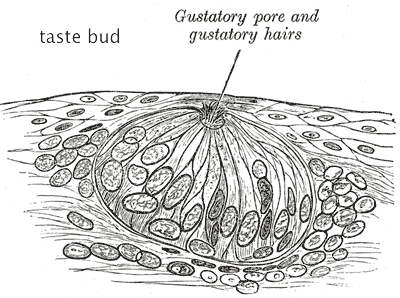
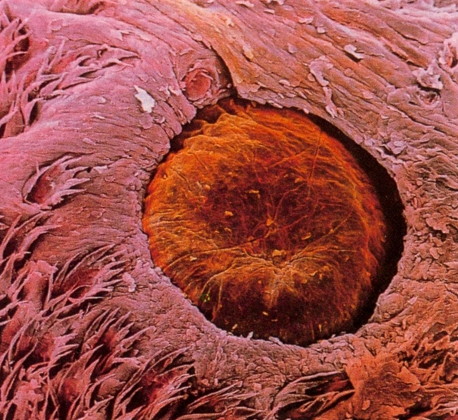
There are only five basic tastes -- that is, only five particular molecules that one or another neuron responds to on the tongue:
Bitter - alkaloids
Sweet - sugars
Salt - sodium chloride
Sour - acids
Umami - glutamate
Umami or savoriness involves a sensitivity to glutamate (which you
may remember as
one of the neurotransmitters). You
find it in aged cheese, tomatos, mushrooms, meat, and soy sauce. It is
best known as monosodium glutamate, which is used to enhance the flavor
of meat.
We experience salty and sour because the salt and acid ions directly
open ion channels in the sensory neurons. Sweet, bitter, and
umami, on the other hand, bind to proteins that have receptor
sites.
Note also that the tongue is sensitive to touch (hence the idea of
texture
in food), and to temperature and, of course, pain.
Jalapeño
peppers, for example, have a certain taste in the ordinary sense, but
also
provide us with delightful (!) sensations of pain. You might find
it
useful to know that, if your mouth is burning from eating peppers, it
helps
to drink milk, because milk fats dissolve the active chemical (capsaicin)
while
water
merely
spreads it around.
In addition, the tongue is sensitive to cold, which can be triggered
not only by actual low temperatures, but by chemicals such as menthol.
Recent research with mice shows that some mice also have taste buds
that respond to fats.
Apparently, it is a genetic trait, one that may help us to understood
why some people are more attracted to fatty foods than others.
There are people that cannot taste anything. This is
technically known as ageusia.
Fortunately,
it
is
very rare.
Perhaps the biggest part of taste for us is, oddly, smell...
Smell (olfaction)
Smell works much like taste: It is also a “lock and key” sense. This time, it is a matter of moist air being drawn over a piece of specialized mucous membrane about the size of a dime at the top of your nasal cavity.
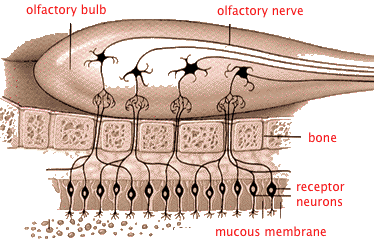
FloralThese are the seven smells suggested by the researcher John Amoore in 1952, when he also outlined his "lock and key" theory of how smells work. But it is far from certain that these are the fundamental scents -- some researchers believe there are many more.
Pepperminty
Musky
Pungent (like spices)
Camphoraceous (like mothballs or muscle liniments)
Ethereal (like dry-cleaning fluid)
Putrid (like rotten eggs)
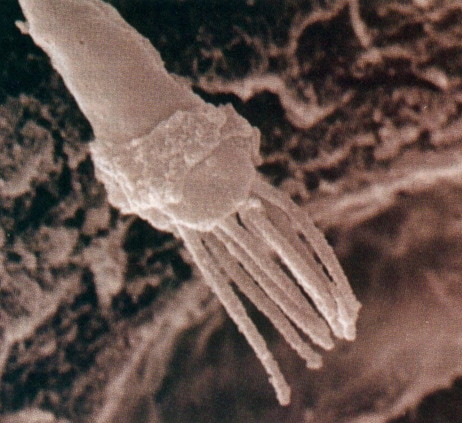
The chemical senses are extremely sensitive, and this goes
especially
for smell. It is believed to be thousands of times more sensitive
than taste and actually accounts for as much as 80 to 90% of what we
perceive as flavor. There are roughly 40 million smell receptor cells
in humans. Dogs have us beat, paws down, with 100 million cells.
But they don't even rate compared with rabbits, with one billion
cells. Most mammals have a good sense of smell, especially
carnivores and their prey (for very obvious reasons). Primates,
however, have a relatively poor sense of smell. On the other
hand, cetaceans (whales and dolphins) have no sense of smell at
all!
A lack of the sense of smell in humans is called anosmia.
There has been considerable debate over many years about the existence of a smell-like sense that can detect the presence of molecules called pheromones. Many animals clearly can smell the presence of a potential mate over great distances. Male silkworms can detect even a single molecule that indicates a female! (Note that it is the antennae that serve as smell organs in insects.)
People can certainly smell
other people -- but is there a special smell that doesn’t really have a
particular odor, but rather leads us to feel, well, those special “I
want
you” feelings? The jury is still out on that.
Touch (tactile)
The skin actually has three types of sensation: Pressure, temperature, and pain.
Pressure is a simple matter of mechanical distortion, the
bending
of the dendrites of a mechanoceptor.
When
bent,
the
stress
cause the opening of channels, the exchange of ions, and, of
course,
the firing of the neuron. In some cases, the dendrites are embedded in
capsules which, when compressed, stimulate the neuron. Plus different
neurons are sensitive to different kinds of pressure: light
touch,
firm pressure, and
vibration.
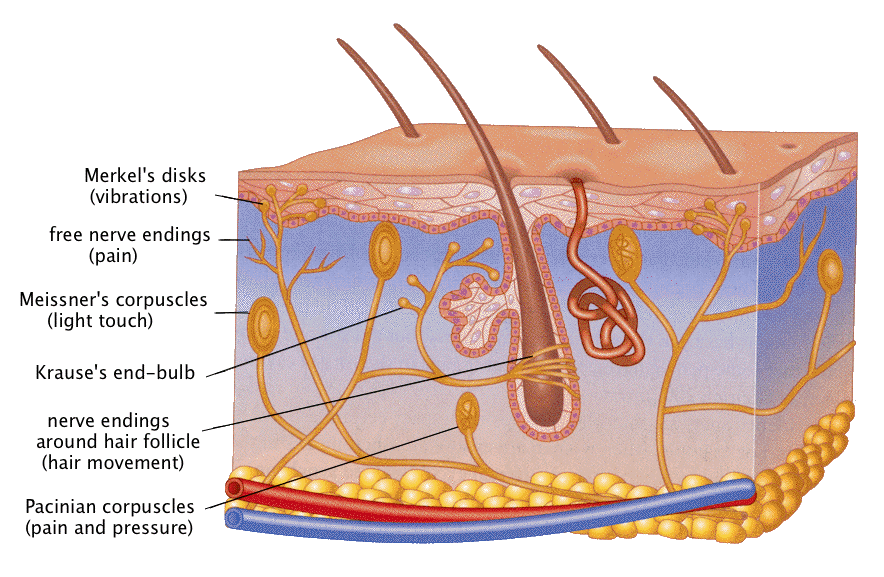
Temperature seems to be a very direct influence of the heat or cold
opening certain ion gates. There seem to be several of these
temperature-sensitive neurons, each with their own range of sensitivity.
It is interesting to note that menthol can also spark the cold receptors, and make us believe we are feeling cold when we are not! It is also peculiar that, when we touch a thermal grill -- a surface that has alternating lines of cold and heat -- we feel neither heat nor cold, but pain!
Kinesthetic sense
The kinesthetic sense is based on receptor neurons in the muscles
and
joints that basically work on the mechanical distortion
principle.
Some of these receptors are mechanoceptors just like those in the skin;
others are spindles
that
begin to fire when stretched.
Vestibular sense
The vestibular sense tells you which way is up, how your body is
oriented
in relation to up, and how your body is moving in space. The
sensations
are based on hair cells -
mechanoceptors with dendrites that resemble brushes. In the inner
ear, there is a special
arrangement
of three semicircular canals around a central area. In
the
semicircular canals, the motion of the fluid as you spin causes
gelatinous
lumps called
cupulas to bend one way or the other, which in turn
causes the hair cells to bend. The three canals are oriented at
roughly
90º to each other, and so give you spinning information in all
three
dimensions.
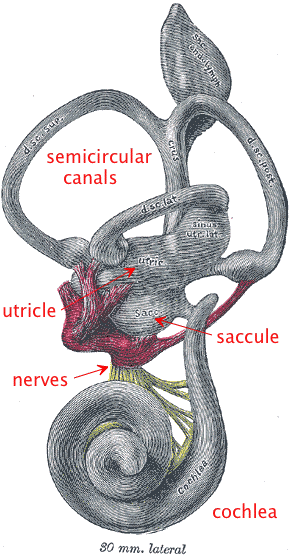
The vestibular sense is also connected to parts of the brain that tell you when it is time to vomit. This is the cause of motion sickness.
If you spin hard enough and then suddenly stop, the tiny current keeps going for a little bit, and gives you the sensation that you are still spinning, but in the opposite direction. Your brain may try to compensate for this, and cause you to fall or at very least feel dizzy.
You can also confuse these canals when you take a shower and allow hot or cold water into your ear. The temperature changes can cause currents to develop that wind up feeling just like spinning, and you may get dizzy.
The two central areas of this organ also have hair cells. The hair cells are embedded in gelatinous lumps called maculas, which pull the hairs in one direction or another, depending on whether you are standing upright, bent over one way or another, or standing on your head. The bending of the hair cells again sends signals to the brain which interprets them accordingly.
Hearing (audition)
Hearing is also a matter of hair cells. You recall, I’m sure, the basic structure of the ear: The outer ear canal leads to the ear drum, a thin tissue stretched across the opening. Behind the ear drum, there is a sequence of three tiny bones that slightly amplify the vibrations of the ear drum. They end at another thin tissue that closes the true organ of hearing, called the cochlea. It is actually a tube, first bent in half, then wound up into a coil, and filled with fluid.
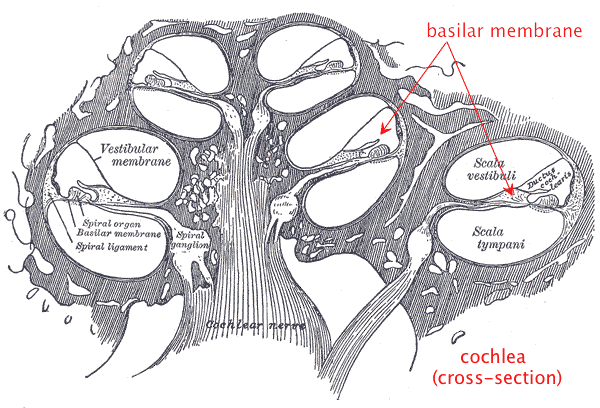
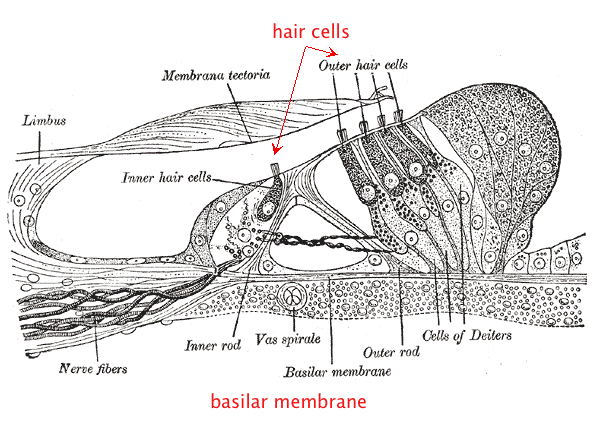
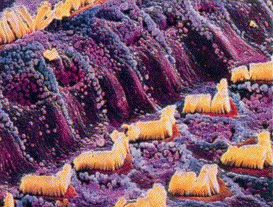
Vision
Vision is different from all the other senses. It involves receptor neurons that are sensitive to light. Light enters through the pupil and lens of the eye and is projected onto the back surface of the eye called the retina. The retina is composed of, among many other things, receptor neurons called rods and cones
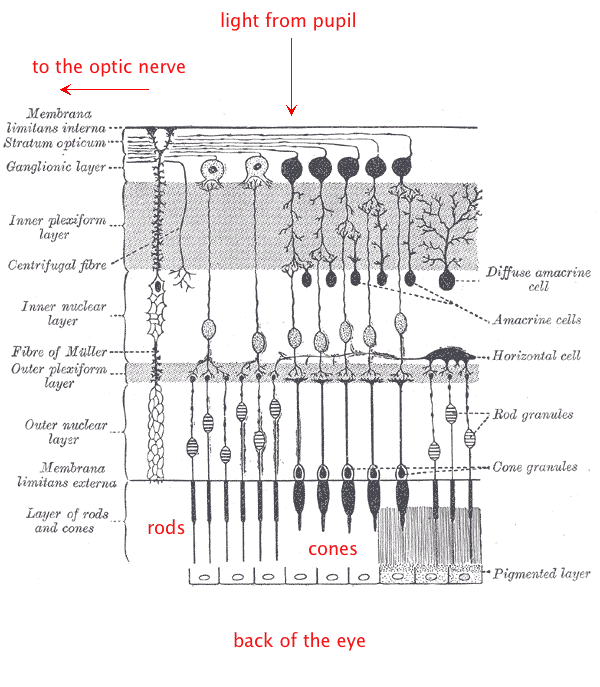
Cones are similar, but involve a chemical called iodopsin
that
is sensitive to more specific wavelengths of light, depending on
pigments
associated with the chemical. One kind of cone responds to red,
one
to green, and one to blue. Each actually responds to a range of
light, and they overlap a bit, so that we are ultimately sensitive to
the entire spectrum of colors. Again, a protein (retinene)
leads
to the release of neurotransmitters, etc.
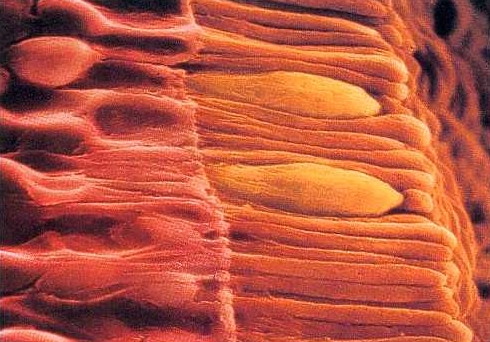
rods and cones
Rods are far more sensitive than cones. This is why you see in
“black and white” when there isn’t much light. Nocturnal animals
tend to be
color-blind, that is, they don’t have any cones, since
color is of little use to them while high sensitivity is. Also,
nocturnal
animals usually have a shiny backing to their retina called a tapetum
that reflects
light
back to the rods. It is usually made up
of
tiny crystals. This is why cats and other animals reflect light
from
their eyes.
The great majority of color-blind people suffer from red-green color
blindness. This comes
about because they lack either red or green cones, so that red and
green are indistinguishable. It is much more common in men than
women, occuring in about 1 in every 20 men. This is because the
genes for red-green colorblindness are on the X chromosome of the 23rd
pair. Since women have two X chromosomes, they must inherit the
problem from both parents. On the other hand, a man with
red-green colorblindness will not transmit the gene to his sons - only
to his daughters (who will probably not be color blind, but may have
color blind sons!).
Some people suffer from blue-yellow
color
blindness, which means
that there is something wrong with their cones for blue. They see
the world in shades of green and red. Since the gene for this
kind of color blindness is on chromosome 7, it is equally distributed
between men and women. It is, however, extremely rare.
Also very rare is complete color blindness, which can mean that the
person only has one kind of cone or none at all.
As with all the senses, there is a great deal more to vision that
this,
but this will do for us.
© Copyright 2002, 2009, C. George Boeree